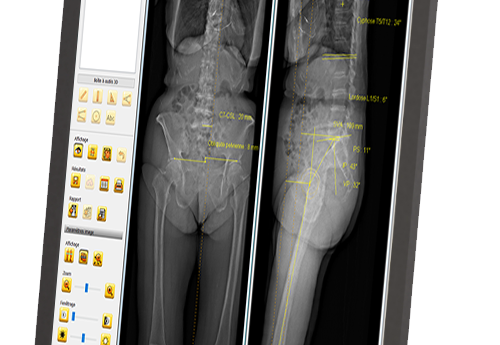EOS Imaging
What is EOS?
The EOS scan is a cutting-edge imaging technique designed specifically for orthopedic and spinal assessment. It was evolved from a Nobel Prize invention. Unlike traditional X-rays, which capture images in a single plane, the EOS system utilises low-dose radiation to generate high-quality 3D images of the entire body. This innovative technology enables healthcare providers to obtain detailed insights into bone structures, joint alignment, and spinal conditions with unparalleled precision.
Images are obtained in your natural standing position or seated. The functional position you live in as opposed to the position you may be operated in.
EOS images provide remarkable detail enabling referring Doctors, Physiotherapists and Chiropractors to better diagnose and plan an effective course of treatment.
EOS is helpful where patients want to limit their exposure to radiation and where long-length, weight-bearing images are needed and in conditions where regular or repeated scans are required.
What happens during an EOS scan?
You will be asked to step inside the scanner and remain still.
The scanner moves vertically and will pass from head to toe. The scanner will not touch you.
Two perpendicular x-ray tubes and detectors take images from front and side views simultaneously. These scans allow doctors to create precise life-size 3D models of your skeleton.
Your x-ray will be conducted by an experienced radiographer.
How long does an EOS scan take?
The actual scan itself will take approximately 20 seconds! Super quick! We book EOS scans in a 20 minute slot to allow time for patient registration and scan set up.
Do I need an appointment for an EOS?
It is necessary to make an appointment for most medical imaging scans and we will endeavour to find a time that is convenient for you.
Why have I been referred for an EOS scan?
EOS uses significantly less radiation than traditional x-ray or CT scans, which is particularly important for children or other conditions requiring regular or repeated x-ray exams.
Patients can also be scanned in a seated position, which is ideal for older or frail patients and makes the imaging of smaller children easier.
The EOS scan is utilised across various specialties for:
- Assessing scoliosis and spinal deformities
- Monitoring bone growth and development in children
- Evaluating joint conditions such as osteoarthritis
- Planning surgical interventions with precision
How do I prepare for an EOS Scan?
There is no specific preparation for an EOS scan, we recommend you wear comfortable loose fitting clothing without metal buckles, fasteners, or zips. In some cases, you may be asked to change into a gown.
Some important things to remember when attending your appointment:
- Bring your referral letter from your doctor
- If you’ve had imaging of the region we’re scanning, please bring any previous ultrasound, x-ray, CT or MR images and/or results if they were performed at another location
- Leave jewellery and valuables at home
Please inform us if:
- there is any chance you may be pregnant. If so you will be unsuitable for an EOS scan due to the small dose of radiation that is used.
- you have had any procedures or have any implants in these areas, please let the radiographer know.
What are the risks of having an EOS?
Although EOS imaging does involve radiation, this is minimal.
The MicroDose technology uses automatic dose adjusters and detectors to deliver a dose that’s as low as possible without compromising image quality. An EOS scan uses a significantly lower radiation dose of less than 10% compared to traditional X-ray.
How much does it cost?
EOS Scans at Vision Radiology are bulk billed (no out of pocket expense) to Medicare, provided that all Medicare eligibility requirements have been met.
For Chiropractor referrals, Medicare only covers the cost of one full spine X-ray (including EOS Scans) per 12 month period.
You will be advised of any costs involved with your EOS Scan at the time of booking.
Where do I get my results?
Our radiologists (imaging specialist doctor) will view your images and write a report as soon as possible. Reports are sent to your referring doctor and are available within 48 hours. Make an appointment with your referring doctor to discuss the results of your scan.

We offer accessible services by bulk billing almost all examinations and procedures. To find out more, visit our billing information page.
Complete our booking form and one of our friendly staff will contact you – it’s quick, and easy. Click on the below link and follow the simple steps. Remember to have your referral handy.


















